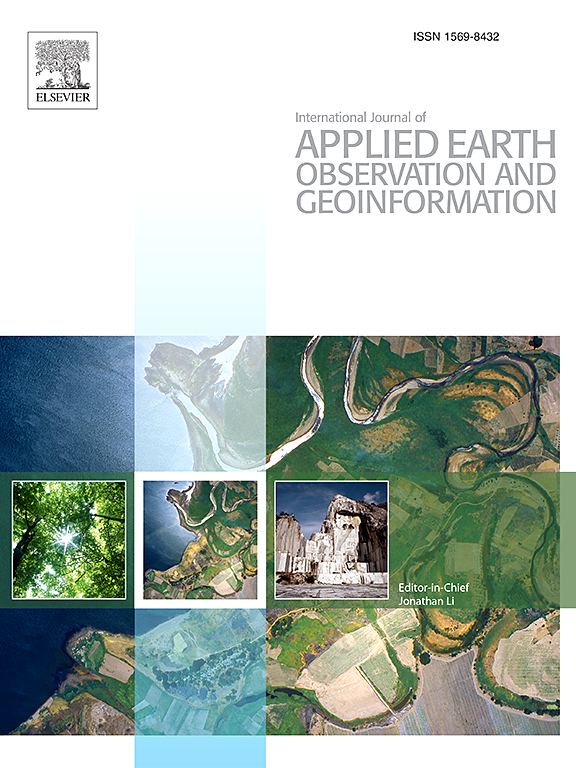Large-area urban TomoSAR method with limited a priori knowledge and a complex deep learning model
IF 7.6
Q1 REMOTE SENSING
International journal of applied earth observation and geoinformation : ITC journal
Pub Date : 2025-04-08
DOI:10.1016/j.jag.2025.104521
引用次数: 0
Abstract
Buildings are crucial to cities, and tomographic synthetic aperture radar (TomoSAR) is an important tool for monitoring the heights, linear deformations and thermal amplitudes of buildings. However, existing TomoSAR height inversion methods do not fully leverage a priori knowledge, compromising the accuracy of deformation estimation; deep learning-based methods involve the integration of multiple steps, complicating the process. Additionally, the computational inefficiency of existing algorithms significantly hinders the large-scale practical deployment of TomoSAR. To address the above issues, this study proposes a novel large-area urban TomoSAR method integrating limited a priori knowledge constraints with a complex-valued (CV) deep learning model. By refining scatterer types and Permanent Scatterer (PS) height sample sets under limited a priori height data constraints, the proposed CV-TomoPS-Net establishes an end-to-end framework for scatterer classification and PS height regression. Additionally, the proposed fast beamforming method, paired with an adaptive spatial search mechanism, enables rapid large-area inversion of deformation and thermal amplitude parameters. Experiments were conducted in Shenzhen city using COSMO-SkyMed SAR data from 2020 to 2023 and limited a priori data. Results show that the proposed method improves the accuracy of scatterer type classification by 16 %, reduces the height calculation error by 30 %, and improves the monitoring efficiency by 80 % compared with the traditional beamforming method. Validation via corner reflectors deformation monitoring confirmed reliability, with a 1.5 mm average error. These results highlight the practical applicability of the proposed method for large-scale urban monitoring and its potential to provide technical support for sustainable urban development.
基于有限先验知识和复杂深度学习模型的大面积城市TomoSAR方法
建筑物对城市至关重要,层析合成孔径雷达(TomoSAR)是监测建筑物高度、线性变形和热幅值的重要工具。然而,现有的TomoSAR高度反演方法没有充分利用先验知识,影响了变形估计的准确性;基于深度学习的方法涉及多个步骤的集成,使过程复杂化。此外,现有算法的计算效率低下严重阻碍了TomoSAR的大规模实际部署。为了解决上述问题,本研究提出了一种将有限先验知识约束与复值(CV)深度学习模型相结合的大面积城市TomoSAR方法。CV-TomoPS-Net通过在有限先验高度数据约束下细化散射体类型和永久散射体(PS)高度样本集,建立了一个端到端的散射体分类和PS高度回归框架。此外,本文提出的快速波束形成方法与自适应空间搜索机制相结合,实现了形变和热幅值参数的快速大面积反演。利用COSMO-SkyMed 2020 - 2023年的SAR数据和有限的先验数据在深圳市进行了实验。结果表明,与传统波束形成方法相比,该方法的散射体类型分类精度提高了16%,高度计算误差降低了30%,监测效率提高了80%。通过角反射镜变形监测验证了可靠性,平均误差为1.5 mm。这些结果突出了所提出的方法在大规模城市监测中的实际适用性及其为城市可持续发展提供技术支持的潜力。
本文章由计算机程序翻译,如有差异,请以英文原文为准。
求助全文
约1分钟内获得全文
求助全文
来源期刊

International journal of applied earth observation and geoinformation : ITC journal
Global and Planetary Change, Management, Monitoring, Policy and Law, Earth-Surface Processes, Computers in Earth Sciences
CiteScore
12.00
自引率
0.00%
发文量
0
审稿时长
77 days
期刊介绍:
The International Journal of Applied Earth Observation and Geoinformation publishes original papers that utilize earth observation data for natural resource and environmental inventory and management. These data primarily originate from remote sensing platforms, including satellites and aircraft, supplemented by surface and subsurface measurements. Addressing natural resources such as forests, agricultural land, soils, and water, as well as environmental concerns like biodiversity, land degradation, and hazards, the journal explores conceptual and data-driven approaches. It covers geoinformation themes like capturing, databasing, visualization, interpretation, data quality, and spatial uncertainty.
 求助内容:
求助内容: 应助结果提醒方式:
应助结果提醒方式:


